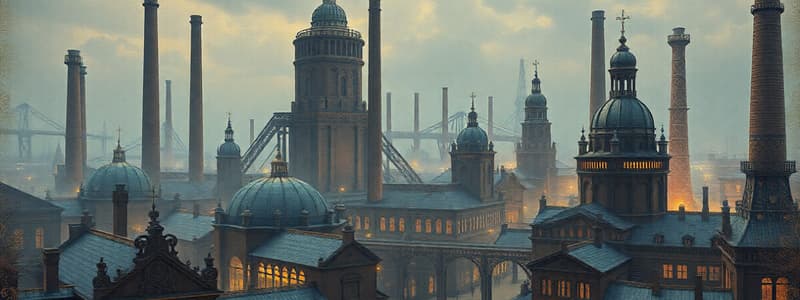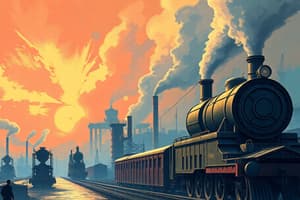Podcast
Questions and Answers
What percentage of the Russian population was comprised of serfs in 1850?
What percentage of the Russian population was comprised of serfs in 1850?
- Around two-thirds (correct)
- About half
- Less than one-fourth
- Approximately one-third
What was a significant obstacle to Russia's industrial growth?
What was a significant obstacle to Russia's industrial growth?
- Abundant natural resources
- A large middle class
- Strong industrial support from the government
- Limited education opportunities (correct)
Where was the largest industrial cluster in Russia located in 1850?
Where was the largest industrial cluster in Russia located in 1850?
- Kiev
- Moscow
- St. Petersburg
- Łódź (correct)
How did the social elite in Russia approach new ideas and technologies?
How did the social elite in Russia approach new ideas and technologies?
What was a contributing factor to the limited readiness of the Russian population for widespread industrialization?
What was a contributing factor to the limited readiness of the Russian population for widespread industrialization?
What was a primary focus of the Japanese state during the industrialization process?
What was a primary focus of the Japanese state during the industrialization process?
How did Japan enhance its industrial expertise during the Meiji period?
How did Japan enhance its industrial expertise during the Meiji period?
What significant challenge prompted Japan to pursue imperialism?
What significant challenge prompted Japan to pursue imperialism?
What role did military considerations play in Japan's industrial choices?
What role did military considerations play in Japan's industrial choices?
What was one of the modernization efforts implemented by the Meiji reformers?
What was one of the modernization efforts implemented by the Meiji reformers?
What was a significant impact of the Sino-Japanese War of 1894-95 on Japan?
What was a significant impact of the Sino-Japanese War of 1894-95 on Japan?
Which system did Japan adopt as part of its modernization process?
Which system did Japan adopt as part of its modernization process?
What was a commonality shared by the industrial revolutions of Japan and other countries?
What was a commonality shared by the industrial revolutions of Japan and other countries?
What main event highlighted the need for reform in Russia during the 1850s?
What main event highlighted the need for reform in Russia during the 1850s?
Which factor significantly hindered industrialization in Russia compared to Britain and Germany?
Which factor significantly hindered industrialization in Russia compared to Britain and Germany?
What key achievement in Russian industrialization was completed in 1903?
What key achievement in Russian industrialization was completed in 1903?
How did government support contribute to Russian industrialization?
How did government support contribute to Russian industrialization?
In what way was Japan's industrialization different from that of Russia?
In what way was Japan's industrialization different from that of Russia?
What role did Sergei Witte play in Russia's industrial efforts?
What role did Sergei Witte play in Russia's industrial efforts?
What was the rate of industrial output growth in Russia during the 1890s?
What was the rate of industrial output growth in Russia during the 1890s?
What was a significant limitation of Russia's transportation infrastructure in the late 19th century?
What was a significant limitation of Russia's transportation infrastructure in the late 19th century?
What sectors did Japanese reformers consider too important to leave to the private sector during industrialization?
What sectors did Japanese reformers consider too important to leave to the private sector during industrialization?
What was one of the major goals of sending Japanese students abroad between 1868 and 1900?
What was one of the major goals of sending Japanese students abroad between 1868 and 1900?
Which of the following measures did the Meiji government NOT adopt to promote industrial innovation?
Which of the following measures did the Meiji government NOT adopt to promote industrial innovation?
By what factor did Japan's total industrial production increase between 1870 and 1913?
By what factor did Japan's total industrial production increase between 1870 and 1913?
What was a significant outcome of Japan's industrialization regarding raw materials?
What was a significant outcome of Japan's industrialization regarding raw materials?
Which measures did Japan implement to help establish a modern military?
Which measures did Japan implement to help establish a modern military?
What was a major social consequence of the Meiji government’s industrial policies?
What was a major social consequence of the Meiji government’s industrial policies?
How did Japan's industrialization influence its status by 1914?
How did Japan's industrialization influence its status by 1914?
What inspired Japan to embrace reform and industrialization in the mid-19th century?
What inspired Japan to embrace reform and industrialization in the mid-19th century?
Which key figure is noted for pushing Japan's industrial revolution through the establishment of multiple companies?
Which key figure is noted for pushing Japan's industrial revolution through the establishment of multiple companies?
What was Japan's initial focus in its industrialization efforts during the Meiji period?
What was Japan's initial focus in its industrialization efforts during the Meiji period?
How did Japan's approach to industrialization differ from that of Europe?
How did Japan's approach to industrialization differ from that of Europe?
What was a significant technological advancement during Japan's industrial revolution?
What was a significant technological advancement during Japan's industrial revolution?
What challenge did Japan face in terms of industrial resources around 1850?
What challenge did Japan face in terms of industrial resources around 1850?
Which international influence significantly contributed to Japan's modernization during the Meiji period?
Which international influence significantly contributed to Japan's modernization during the Meiji period?
What demographic characteristic of Japan facilitated the establishment of a productive working class?
What demographic characteristic of Japan facilitated the establishment of a productive working class?
Flashcards
Serfdom in Russia
Serfdom in Russia
The majority of Russia's population in 1850 were serfs, bound to the land and controlled by the state or nobility.
Limited Education in Russia
Limited Education in Russia
Russia's limited education system hampered industrial growth by restricting opportunities for societal advancement. Many people lacked the skills needed for factory work.
Limited Consumer Market in Russia
Limited Consumer Market in Russia
The economic landscape in Russia was dominated by a small middle class and limited demand for manufactured goods beyond basic necessities. This hindered the growth of a consumer market, vital for industrial expansion.
Industrial Cluster in Łódź
Industrial Cluster in Łódź
Signup and view all the flashcards
Poverty's impact on Russian Industrialization
Poverty's impact on Russian Industrialization
Signup and view all the flashcards
Russia's Industrial Revolution
Russia's Industrial Revolution
Signup and view all the flashcards
Crimean War (1853-1856)
Crimean War (1853-1856)
Signup and view all the flashcards
Lack of engineers and technical training
Lack of engineers and technical training
Signup and view all the flashcards
Trans-Siberian Railway
Trans-Siberian Railway
Signup and view all the flashcards
Sergei Witte
Sergei Witte
Signup and view all the flashcards
Government Support in Russia
Government Support in Russia
Signup and view all the flashcards
Japan's Industrialization
Japan's Industrialization
Signup and view all the flashcards
Government Support
Government Support
Signup and view all the flashcards
Government-led Industrialization in Japan
Government-led Industrialization in Japan
Signup and view all the flashcards
Foreign Influences on Japanese Industrialization
Foreign Influences on Japanese Industrialization
Signup and view all the flashcards
Military Motivation for Japanese Industrialization
Military Motivation for Japanese Industrialization
Signup and view all the flashcards
Imperialism Fuelled by Industrialization in Japan
Imperialism Fuelled by Industrialization in Japan
Signup and view all the flashcards
Japan's Rapid Industrial Growth
Japan's Rapid Industrial Growth
Signup and view all the flashcards
Common Threads in Global Industrial Revolutions
Common Threads in Global Industrial Revolutions
Signup and view all the flashcards
Government Influence and Military Considerations in Industrialization
Government Influence and Military Considerations in Industrialization
Signup and view all the flashcards
Acquiring Industrial Knowledge in Japan
Acquiring Industrial Knowledge in Japan
Signup and view all the flashcards
Japanese State Promotion of Heavy Industry
Japanese State Promotion of Heavy Industry
Signup and view all the flashcards
Military Influence on Industrial Choices
Military Influence on Industrial Choices
Signup and view all the flashcards
Imperial Expansion and Industrial Growth
Imperial Expansion and Industrial Growth
Signup and view all the flashcards
Sino-Japanese War and Resources
Sino-Japanese War and Resources
Signup and view all the flashcards
Modernization Efforts for Industrialization
Modernization Efforts for Industrialization
Signup and view all the flashcards
Global Comparisons of Industrialization
Global Comparisons of Industrialization
Signup and view all the flashcards
Infrastructure Investment for Industry
Infrastructure Investment for Industry
Signup and view all the flashcards
Military-Industrial Complex in Japan
Military-Industrial Complex in Japan
Signup and view all the flashcards
Meiji Restoration
Meiji Restoration
Signup and view all the flashcards
Threat to National Security
Threat to National Security
Signup and view all the flashcards
Meiji Reforms Focus
Meiji Reforms Focus
Signup and view all the flashcards
Eiichi Shibusawa's Role
Eiichi Shibusawa's Role
Signup and view all the flashcards
Early Japanese Industrialization Focus
Early Japanese Industrialization Focus
Signup and view all the flashcards
Takeo Yamanobe's Contribution
Takeo Yamanobe's Contribution
Signup and view all the flashcards
Divergent Approach to Industrialization
Divergent Approach to Industrialization
Signup and view all the flashcards
Steam Train Print Symbolism
Steam Train Print Symbolism
Signup and view all the flashcards
Study Notes
Russian Industrialization
- Russia's industrial plant was old and small, developed originally under Ivan the IV.
- The existing industry was outdated by the 1880s.
- The country had only one real railroad line.
- The country had limited efforts to import technology.
- The ambition to industrialize faced numerous obstacles.
Lack of Government Support
- Compared to other countries, Russia's government support was insufficient to spur industrialization.
- This was partly due to the country's poverty; the population's limited ability to purchase goods beyond basic necessities.
Limited Expansion
- In 1850, only a fraction of Russia's population (roughly two-thirds) lived in locations bound to the lands.
- Most of the population lacked formal education, making it difficult to develop industrial potential.
- Few Russian industries were established.
- Most enterprises were small textile mills, owned by German businessmen.
Studying That Suits You
Use AI to generate personalized quizzes and flashcards to suit your learning preferences.




